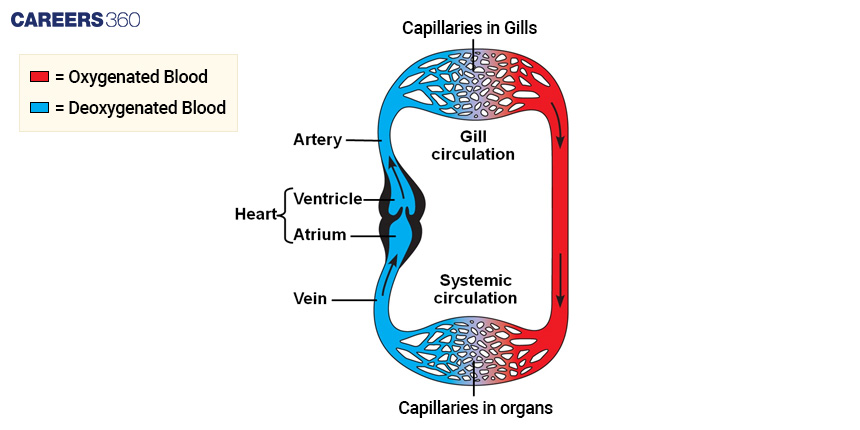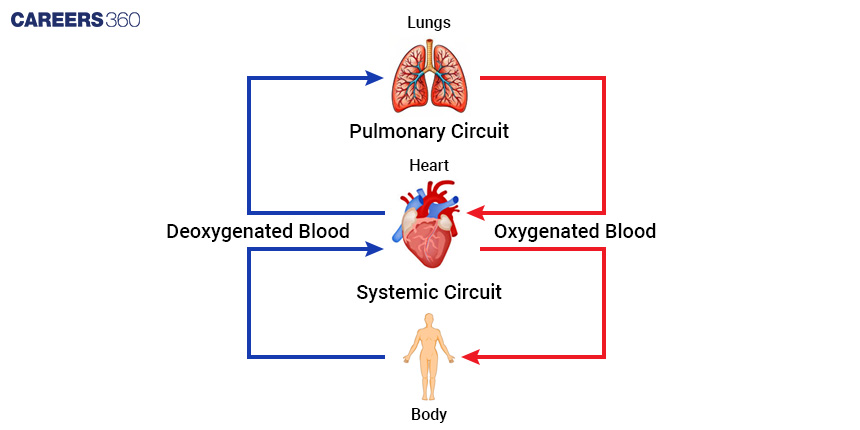Difference between Single and Double Circulation
Blood Circulation
Blood is circulated throughout the animal body, a process through which nutrients, gases, and waste products are delivered to their respective sites of consumption as well as production. The types of closed circulatory systems depend on the number of circuits, which include single circulation and double circulation. This 'tubular' system, within which the blood flows, is a system of the blood vessels, either the arteries or the veins, and it is called the closed circulatory system. In single circulation, the blood will flow to and from the heart in one single path. In double circulation, the circulation of the blood is carried in two circuits that are connected by the heart with blood that is oxygenated and deoxygenated. The following article brings out the differences between the single and the double circulation in a detailed study.
Single Circulation

Single circulation is the original type of circulatory system present and is associated with most fishes. These organisms have a two-chambered heart representation made out of one atrium and one ventricle.
The Anatomy Of The Heart
The circulatory system of fish involves the flow of deoxygenated blood away from the body tissues.
It pumps deoxygenated blood to the gills so that it can get oxygenated there.
Fully oxygenated blood coming from the gills- flows directly to all the different body tissues.
The blood that had left the heart returns deoxygenated from tissues.
Efficiency And Adaptation
Blood flows through a single circulatory pathway.
it is inefficient in that blood flows at a considerably low pressure.
Suitable to the metabolic requirements of fishes.
Double Circulation
It is one of the circulatory systems of birds and mammals. The animals have a four-chambered heart, which comprises two atria and two ventricles.

Structure
The heart is divided into two separate circuits: systemic and pulmonary circulation.
The left atrium receives oxygenated blood from the lungs and sends it to the left ventricle.
The right atrium receives deoxygenated blood coming from the body tissues and sends it to the right ventricle.
Systemic Circulation
Oxygenated blood is ejected out of the left ventricle into the aorta and pumped to various body tissues.
Once the oxygen and nutrients have been supplied, the deoxygenated blood returns to the right atrium.
Pulmonary Circulation
From the right ventricle, circulation sends deoxygenated blood to the lungs through the pulmonary artery.
The now oxygenated blood returning to the left atrium again from the lungs enters there by the pulmonary vein.
Efficiency And Adaptation
Blood passes through two different pathways, which allows for an effective oxygenation of blood and nutrient delivery.
This system has a higher pressure flow of blood.
It supports the higher metabolic demands that exist in birds and mammals.
Table: Main Differences Between Single And Double Circulation
Feature | Single Circulation | Double Circulation |
Blood Flow | Blood moves through the heart only once in the entire circuit | Blood flows through the heart twice to complete the full circuit |
Heart Chambers | Two-chambered heart (one atrium and one ventricle) | Four-chambered heart (two atria and two ventricles) |
Blood Type in Heart | Only deoxygenated blood is transported | Both oxygenated and deoxygenated blood circulate through the heart |
Post-Oxygenation Blood Flow | Blood does not come back to the heart after a gaseous exchange in gills; goes directly to the tissues | Blood comes back to the heart after a gaseous exchange in lungs and then will be pumped towards body parts |
Pathway | Single pathway | Two pathways: systemic and pulmonary circulation |
Efficiency | Less efficient low pressure | More efficient high-pressure |
Occurrence | Presence in fishes | Presence in birds and mammals |
Significance In Modern Biology
From this topic, one of the most significant things to learn is the difference between single and double circulation. This difference can help us see how various animals in nature have evolved differently. Their places of living have made sure that the evolved circulatory systems go along with their respective needs.
Conclusion
In other words, single circulation represents a single path for blood flow through a fish-like two-chambered heart. In contrast, double circulation represents a split system of two separate blood flow circuits through a four-chambered heart—both more efficient and, concerning increased metabolic demands, more supportive for mammals and birds. Recognition of these differences helps to understand the relationships of cardiovascular systems across species.
Frequently Asked Questions (FAQs)
Understanding blood circulatory systems is all about the adaptation of organisms to their environments. If further medical knowledge correlates with cardiovascular health, this will be useful when studying evolutionary biology. The reason behind this idea is that understanding the circulatory system adds much insight into how different species have adapted themselves and evolved in various ways.
The most striking difference between single and double circulation would be that in one complete cycle, blood travels once through the heart in the case of single circulation and twice through the heart in double circulation. Single circulation characterises the case of fish, and double circulation is characteristic of high vertebrates like birds and mammals.
The double circulations partition the body into two circuits: the pulmonary circuit, composed of the lungs themselves, and the systemic circuit, composed of the remaining parts of the body. The division could thus provide the advantage of higher blood flow rates to the parts of the body. A greater pressure build-up in the systemic circuit through isolated blood flow could occur to enhance oxygen and nutrient delivery to tissues.
The best example of animals having a single circulation is fish. On the other hand, birds and mammals are terrestrial animals that exhibit double circulation.
Of the two, double circulation is more efficient. Hence, oxygenated and deoxygenated blood go in separate ways, allowing a higher pressure in the systemic circuit to enable its constituents to be delivered far more effectively to tissues in the body.